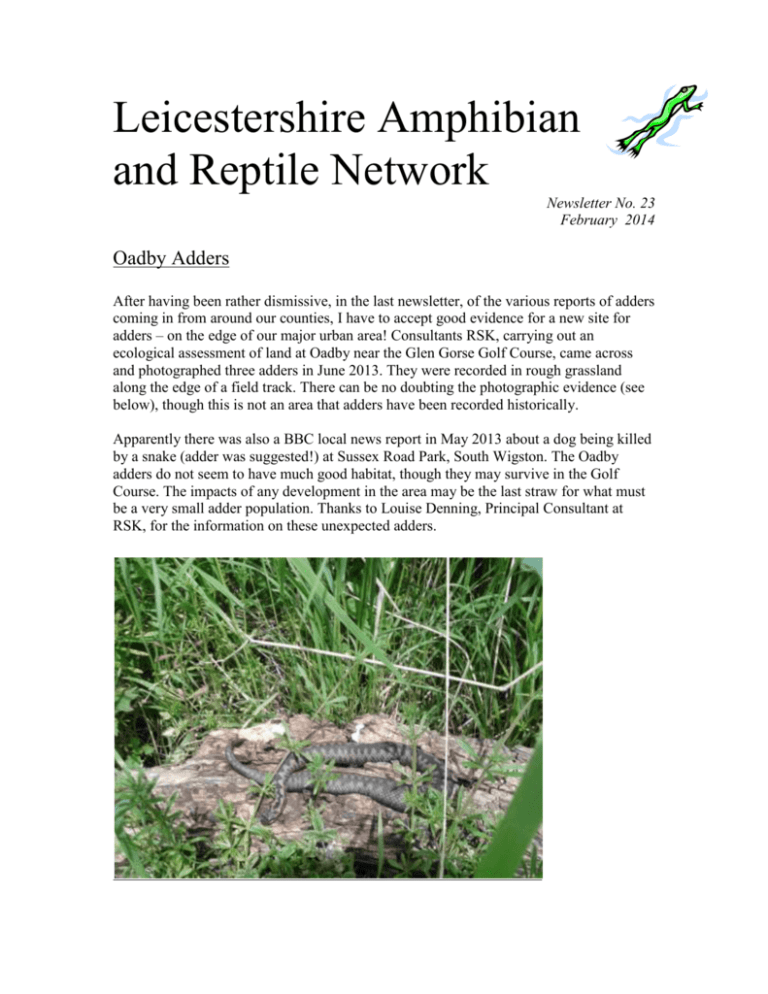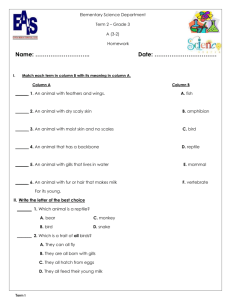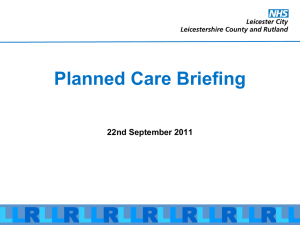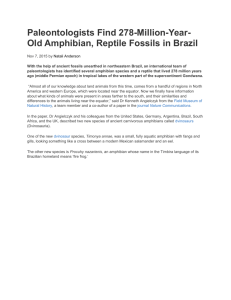LARN news - issue 23
advertisement

Leicestershire Amphibian and Reptile Network Newsletter No. 23 February 2014 Oadby Adders After having been rather dismissive, in the last newsletter, of the various reports of adders coming in from around our counties, I have to accept good evidence for a new site for adders – on the edge of our major urban area! Consultants RSK, carrying out an ecological assessment of land at Oadby near the Glen Gorse Golf Course, came across and photographed three adders in June 2013. They were recorded in rough grassland along the edge of a field track. There can be no doubting the photographic evidence (see below), though this is not an area that adders have been recorded historically. Apparently there was also a BBC local news report in May 2013 about a dog being killed by a snake (adder was suggested!) at Sussex Road Park, South Wigston. The Oadby adders do not seem to have much good habitat, though they may survive in the Golf Course. The impacts of any development in the area may be the last straw for what must be a very small adder population. Thanks to Louise Denning, Principal Consultant at RSK, for the information on these unexpected adders. Herpetofauna on Wildlife Trust Reserves The article in the last LARN newsletter on amphibians and reptiles on Wildlife Trust reserves served to draw out quite a few additional records, thus leaving the figures originally quoted somewhat inaccurate. There are now 27 of the 32 reserves which hold amphibian or reptile populations (or both). New records include a frog at Charley Woods, the first herp at this site. Also, there are old records of a frog at Wymeswold Meadows and a smooth newt at Dimminsdale. David Nicholls reminded me that he had recorded slow-worms at Ulverscroft. There are now three reserves which support the uncommon slow-worm. A pleasing eight sites have records of the fully protected great crested newt. The most important reserves for amphibians and reptiles remain Rutland Water and Holwell, together with Charnwood Lodge, Lucas Marsh and Wymondham Rough. Neill Talbot is drawing up a schedule of targeted amphibian and reptile surveys at Wildlife Trust sites for the next three years, which should confirm or even expand our knowledge of protected herp populations. Surveys are planned at at least 15 sites, with the priorities being Cribbs Meadow and Merrys Meadows (amphibians), Ketton Quarry (reptiles) and Charnwood Lodge and Rutland Water (both groups). Stoneywell Slow-worms The National Trust has acquired a new property in Leicestershire – Stoneywell, an attractive Arts and Crafts Movement house close to the Ulverscroft nature reserve. The building (not yet open to the public) comes with significant land (gardens and woodland). Jamie Gould of the gardening team reported a significant slow-worm population on the site. There were concerns that the work being undertaken to tidy up the neglected gardens would impact on the slow-worms. However, having taken up this point and visited the site with Stewart Alcock who heads the development team, I am reassured that any work done by the National Trust will be sensitive to the natural environment, retaining wild areas and features such as compost heaps and grass tussocks which will support slow-worms. Watch this space for developments at Stoneywell. Alpine Newt An alpine newt has been recorded from a garden pond on Shanklin Drive, Leicester. This is the third sighting of this introduced species in this area, on the boundary of the city and Oadby. Heather Log Piles In a follow-up to the note on Heather Parish Council’s snake “problem” in the last newsletter, the village seems to have accepted that their reptiles are harmless grass snakes, not adders. They are planning to create basking habitat by putting down log piles covered with wood chips so that the snakes are more visible. Focus On: Common Lizard The common lizard is actually something of a rarity in Leicestershire and Rutland, its distribution being focussed on Charnwood Forest, with another concentration of records in the heathland habitats around Moira in North West Leicestershire, and few scattered sightings elsewhere, mainly in Rutland. Having said that, new sites for common lizard seem to pop up regularly. The core population in Charnwood Forest is to be found at sites such as Bardon Hill, Ulverscroft, Iveshead, Bradgate Park and Charnwood Lodge. Around Moira, a group of sites supporting lizards includes Conkers Waterside, Stonepits, Newfield Colliery, and Donisthorpe Woodland Park. It might be beneficial to look at Hicks Lodge, especially the significant area of heather growing adjacent to Newfield Colliery. There also seems to be a good population at North Luffenham Quarry. Elsewhere numbers appear to be small, though the largest counts have been seen at Ketton Quarry (up to 30 reported). The common lizard is a Red Data Book species, and is found on nine Wildlife Trust reserves. Any records are welcome, especially away from the main concentrations. Viviparous Lizard (Lacerta vivipara) 5 4 3 2 1 SK TF 9 8 7 SP 2 3 4 5 6 7 8 9 TL 1 Toad Patrol Project Amphibian and Reptile Conservation are still interested in the effectiveness of toad patrols at protecting migrating toad populations. There were at least three toad patrols in Leicestershire and Rutland but I am not sure that any of them are still active. If you are involved with a local toad patrol, please let me know so that it is on record. NARRS Now is the time to be thinking about volunteering for a local NARRS site. Details are available at the NARRS website: http://www.narrs.org.uk Two-headed Adder In September, the BBC reported and showed a photograph of a two-headed adder! This was essentially two young conjoined twins whose development went awry. This strange specimen was photographed in North Yorkshire by Gordon Cook. Thanks to Phil Cureton for making it known to me. Needless to say, if anyone comes across such an abnormal specimen in our counties, a photograph would be very much welcomed. Local Species Natural England has asked the County Council for names of locally significant species which are not on the “Section 41 list” - that is, they are not already UKBAP species. I have suggested adder and palmate newt, as both are rarities in our counties whilst being not uncommon elsewhere around the country. What NE wants these species identified for is not clear. Sue Timms has suggested that LBAP Species Action Plans might be drafted for these species, so they have some status in planning terms. Records Many thanks to all those who have sent me their reptile and amphibian records for 2013, notably David Nicholls (Naturespot), Charles Gallimore (Rutland NHS) and Steve Woodward, amongst others. With the new season getting underway, please find the time to track down our herpetofauna, and let me know so I can add to the central database. New Publication A recent publication (it came out last year) is “Amphibians and Reptiles” by Trevor Beebee, No.31 in the Naturalists’ Handbook series, now produced by Pelagic Publishing. This is a long-running and respected series of books on varied natural history topics. As well as providing basic data on the species covered, a key feature of the books is their suggestions for projects and small-scale investigations which can be carried out by a competent naturalist. If you are interested in an achievable project related to amphibians or reptiles, this is probably the book to point you in the right direction. Herpetofauna Workers Conference The 2014 Herpetofauna Workers Meeting took place over the weekend of February1-2 at Bristol Zoo – unfortunately I was not able to attend. If anyone did go, I would be very grateful for a brief report which can be included in the next newsletter. Wildlife Trust Leicestershire and Rutland Wildlife Trust has a new headquarters: The Old Mill, 9 Soar Lane, Leicester LE3 5DE 0116 262 9968 -0Leicestershire Amphibian and Reptile Network (LARN) is an informal grouping of people interested in the status and distribution of these two lower vertebrate groups in Leicestershire and Rutland. The group is held together by a newsletter produced on an irregular basis – generally twice a year. The aims of the group are to encourage recording of herpetofauna in the two counties, and to use this data to support conservation initiatives. Anyone wanting to join the group should contact the coordinator, Andrew Heaton, as below. If you have any news for the next edition of this newsletter, do let me know. Andrew Heaton, 19 Rydal Gardens, Ashby de la Zouch, Leics LE65 1FJ Tel. 01530-467904 aheaton@ntlworld.com





